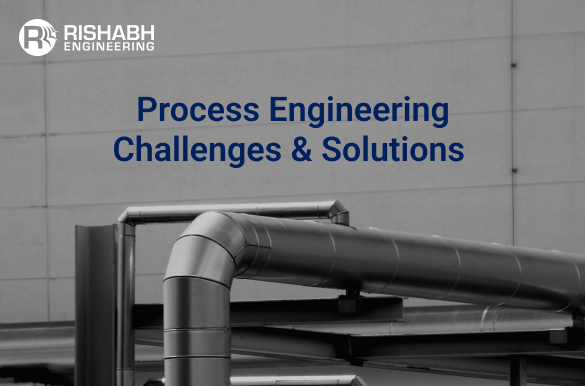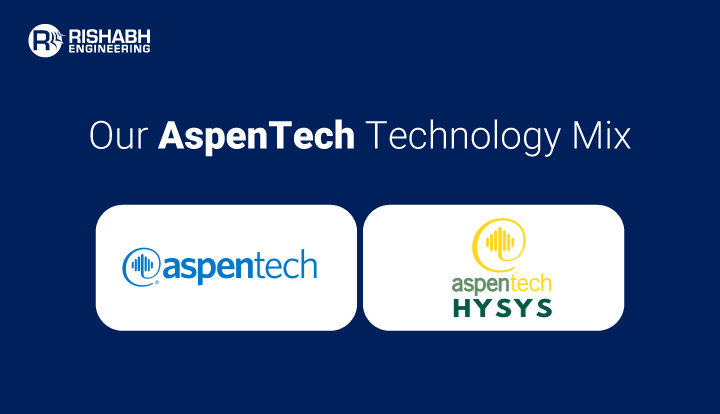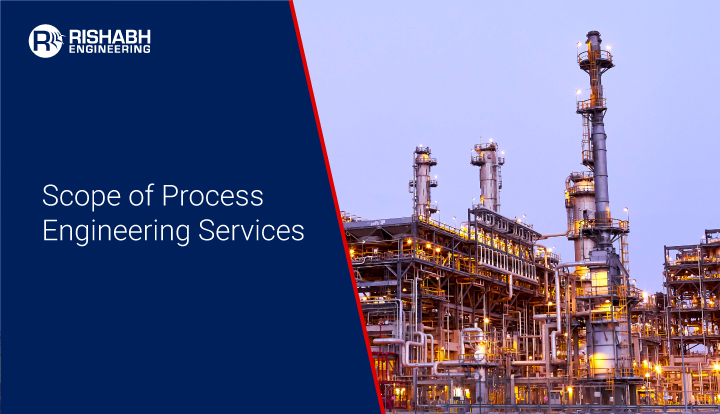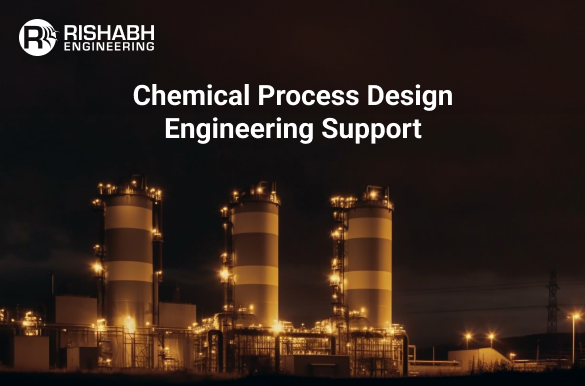
Process Engineering Challenges & How Rishabh Engineering Helps Solve Them
Today’s process engineers face greater challenges than ever before, particularly in sectors like LNG, chemicals, energy, and hydrogen. Engineers are required to create systems that are not only dependable but also environmentally friendly, adaptable enough to meet shifting market needs, and intelligent enough to facilitate in-the-moment judgments. Balancing these demands requires more than just domain expertise calling for advanced digital tools and collaborative design strategies. AspenTech, a leading suite of software for process simulation, optimization, and performance engineering, has become essential in this context.
This blog will explore how multidisciplinary design engineering firms like Rishabh Engineering leverage the full potential of AspenTech tools to tackle modern process engineering challenges with precision, agility, and cross-functional insight.

Key Process Engineering Challenges Today & How to Solve Them
Process engineering has never been more difficult, particularly in sectors like LNG, chemicals, energy, and hydrogen. Not only must engineers create dependable systems, but they also need to be environmentally responsible, adaptable enough to meet shifting market needs, and intelligent enough to facilitate in-the-moment judgments.
Below are the critical issues faced by modern process engineering teams across sectors like oil & gas, chemicals, hydrogen, and renewables and let’s discuss how to solve them.
1. Managing Complex Reaction Mechanisms and Unit Operations:
As industries adopt new feedstock (e.g., bio-based materials, hydrogen blends) and pursue intensified processes, reaction pathways and unit operations have become more sophisticated. Engineers must model these accurately to ensure conversion efficiency, yield optimization, and safety. Traditional tools often fall short in capturing real fluid behavior or kinetic reactions, leading to potential errors in scale-up or equipment sizing. And without precise thermodynamic and kinetic data, there’s a potential risk with process design as it would underperform once implemented in the field.
How To Solve:
Aspen Plus and Aspen HYSYS are strong tools that assist engineers in understanding and simulating the behavior of fluids, chemical reactions, and the effects of numerous factors on the process. By predicting how a process will function in actual settings, engineers can use these methods to scale the design precisely and appropriately size equipment. Particularly when utilizing novel materials like hydrogen blends or bio-based feedstocks, Rishabh Engineering can ensure process efficiency with AspenTech’s comprehensive data on how substances react and behave.
2. Energy Inefficiencies and Sustainability Mandates:
Energy consumption remains a major cost and environmental drivers. Regulatory bodies and stakeholders increasingly demand decarbonization, minimal waste, and energy reuse. Yet, several facilities continue to operate below their energy efficiency potential due to poor integration of utilities or lack of heat recovery systems. Engineers often lack the tools to perform comprehensive energy audits or compare carbon footprints of different process routes during early design phases.
How To Solve:
Rishabh Engineering utilizes Aspen Plus to track the flow of energy through a system, assess total energy consumption, and calculate the carbon footprint of a process. Our team can investigate methods to reduce emissions or reuse heat by identifying energy waste early in the design process. By using less energy and generating less waste, the project becomes more ecologically friendly and efficient, while still achieving important sustainability objectives.
3. Process Integration Across Systems (e.g., Utilities, Main Process, Safety Layers):
Ensuring the seamless operation of the main process units, utility systems (such as cooling water and steam), and safety measures is a major task in process engineering. Oversized systems, mismatched utilities, and delays in safety certifications like HAZOP can result from various teams handling these components independently or from a lack of communication. A truly optimized plant design requires simultaneous consideration of energy, flow, material handling, and emergency response systems.
How To Solve:
Aspen Plus and Aspen HYSYS provide tools that help design and optimize entire process plants by considering how distinct parts of the system work together—like the main process units, utilities (such as steam and cooling water), and safety systems. With these tools, Rishabh Engineering ensures that all aspects of the plant are well-coordinated and integrated, preventing any mismatches between systems and making the design more efficient.
4. Data Fragmentation Across Engineering Teams:
Ensuring the seamless operation of the main process units, utility systems (such as cooling water and steam), and safety measures is a major task in process engineering. Oversized systems, mismatched utilities, and delays in safety certifications like HAZOP can result from various teams handling these components independently or from a lack of communication. This fragmentation results in delays, rework, or even design flaws that are discovered only during commissioning or operations.
How To Solve:
Aspentech’s integrated solutions facilitate real-time data sharing among mechanical designers, process engineers, and other team members. This enables communication between all departments thus making it simpler for everyone to remain in agreement. Delays and design errors are thus prevented because there is a decreased possibility of data loss or misunderstanding.
5. Modeling for Operability and Maintainability:
While simulations often focus on steady-state conditions, real-world operations must contend with fluctuating loads, feed changes, and equipment aging. Engineers face the added challenge of designing systems that are not only optimal on paper but also practical to operate and maintain overtime. Operability constraints—like valve accessibility, maintenance frequency, and safe venting—must be built into the early design phase, which many traditional workflows fail to incorporate effectively.
How To Solve:
Using software like Aspen Plus and Aspen HYSYS, Rishabh Engineering builds realistic models that account for differences in feedstock, shifting production loads, and equipment aging. Engineers can create systems that are easy to use and maintain over time, in addition to having good initial performance, with the aid of these simulations. By considering pragmatic aspects such as valve accessibility and maintenance frequency from the outset, engineers may prevent such issues before they occur.
6. Integration of CAPEX/OPEX Analysis in Early Stages:
Cost estimation is no longer an isolated exercise for procurement or finance teams. Today’s process engineers are expected to evaluate design alternatives not just on technical grounds but also based on lifecycle costs. However, many early-stage designs do not integrate tools for CAPEX and OPEX comparisons, resulting in decisions that may later prove economically unviable.
How To Solve:
From the very beginning of the design process, Rishabh Engineering supports clients by taking into consideration both initial costs (CAPEX) and continuing operating costs (OPEX) by leveraging Aspentech’s advanced software capabilities. This aids engineers in determining the long-term costs of various design possibilities at an early stage, ensuring that their decisions are both technically sound and economical.
7. Dynamic Simulation and Control Validation for Safe Startup/Shutdown:
Static simulations don’t provide a complete picture of plant behavior under transient conditions, especially during startup, shutdown, or emergency scenarios. These periods are often the riskiest, yet traditional designs may not include dynamic simulations to validate control schemes. Engineers must anticipate pressure surges, control loops, and potential trip conditions well in advance, requiring robust dynamic modeling capabilities.
How To Solve:
Software Tools replicate real-world events, such as plant startup, shutdown, and emergency scenarios, are offered by Aspen HYSYS. By testing control systems and anticipating any problems like pressure changes or equipment failures, Rishabh Engineering can ensure the plant operates safely during these crucial periods. This lowers dangers during the most delicate operating periods.
8. Keeping Up with Evolving Compliance and Safety Norms:
From ASME, API, and IEC standards to region-specific emissions norms and process safety regulations, compliance is a moving target. Process engineers must not only ensure baseline adherence but also anticipate upcoming regulatory changes. Without integrated safety tools and frequent updates, maintaining regulatory compliance becomes a reactive—rather than proactive—exercise, increasing project risk.
How To Solve:
Rishabh Engineering uses AspenTech’s safety tools to ensure that their designs adhere to the most recent safety and environmental regulations. This covers both national and international regulations for machinery, pollution, and general plant safety. Rishabh may lower risks, stay ahead of evolving regulations, and create safer, more dependable systems for their clients by utilizing these solutions.
Why Choose a Multidiscipline Design Engineering Partner for AspenTech-Enabled Projects?
Choosing a multidisciplinary design engineering partner for AspenTech-enabled projects ensures a thorough, efficient, and accurate approach to process engineering. To effectively leverage the software’s modeling, simulation, optimization, and implementation capabilities, experts from various technical disciplines collaborate in these teams. Through this collaboration, design problems can be identified early, project schedules are streamlined, and plant performance is generally enhanced. It also facilitates multidisciplinary integration, resulting in safer, more reliable, and more affordable industrial solutions.
Here’s how a multidiscipline design engineering company leveraging Aspentech software can help address process engineering problems:
1. Seamless Cross-Domain Communication
Several specialized teams, including process engineers, mechanical designers, piping specialists, instrumentation experts, and safety officers, are housed under one roof in a multidisciplinary engineering business. This makes it possible to collaborate and communicate easily throughout the entire process.
The team may collaborate from a single platform with software solutions like Aspen Plus and Aspen HYSYS, guaranteeing that everyone is aware of the most recent data. For instance, pipe and mechanical engineers concurrently confirm design viability using the most recent performance data, while process engineers model and optimize chemical processes. This encourages a more integrated approach to problem-solving and lessens the silos that are frequently observed when several disciplines operate independently.
2. Faster Simulation-to-Design Transition
Time efficiency is crucial in any engineering project, and a swift transition from simulations to actual designs has a significant impact. The transition from planning to detailed design occurs more quickly and seamlessly when a heterogeneous team uses AspenTech tools.
For instance, engineers can immediately begin using integrated CAD tools to create precise equipment layouts after executing process simulations in Aspen Plus. By doing this, back-and-forth handover delays are avoided, workflow is accelerated, and projects are completed on time.
3. Reduced Risk of Rework Due to Single-Source Accountability
Working with a multidisciplinary design engineering firm has several benefits, including less errors and rework. Everything remains in line from the start when all engineering specialties collaborate under a single leadership group, ensuring that the design comes together as it should.
This team can verify and check designs in real time with AspenTech’s technologies. Because everyone uses the same data, there is less chance of misunderstandings and expensive corrections that typically occur when teams aren’t in agreement.
4. Better Compliance Management Due to Integrated Reviews
It is imperative that safety regulations, industry standards, and environmental norms be followed. Therefore, it truly makes a difference to work with a diverse design partner who is proficient with AspenTech technologies.
Aspen Plus and Aspen HYSYS are examples of software that allows teams to incorporate compliance checks directly into the process design. Early risk detection, regulatory compliance, and safe and effective project management are all made possible by engineers, which helps to prevent future delays or expensive errors.
Read this blog to learn more about Process Modeling & Simulation Using AspenTech Software in Multidisciplinary Engineering and how it helps value add to your industrial design projects.
Closing Thoughts
Today’s challenges of process engineering & design require strong cross-disciplinary collaboration and clever software tools in addition to technical expertise. When paired with Rishabh Engineering’s diverse knowledge, AspenTech’s software proves to be a potent solution. Our team uses, Aspen Plus for Process Modeling and Aspen HYSYS for Process Simulation, and this ensures that designs are precise, effective, and in line with the changing requirements. The process, mechanical, piping, instrumentation, and safety teams are integrated to lower risks, expedite project schedules, and avoid expensive rework. This cooperative method facilitates smooth data exchange and real-time verification, which makes managing complicated reactions, optimizing energy consumption, and designing for safe operation simpler. Therefore, partnering with a multidisciplinary engineering firm that offers process engineering services by leveraging varied software tools can support in developing smarter, safer, and more sustainable facilities. It is a forward-looking strategy that meets today’s demands while preparing for tomorrow’s challenges.
Ready To Overcome Process Engineering Challenges?
Partner with us to blend technology and multidisciplinary design with precision and for success.
Related Blogs
Related Blogs
Process Modeling & Simulation Using AspenTech Software in Multidisciplinary Engineering
For the ever-evolving world of industrial processes and engineering, the…
Navigating the World of Process Engineering with Rishabh Engineering
Process engineering can be considered the foundation for modern manufacturing,…


